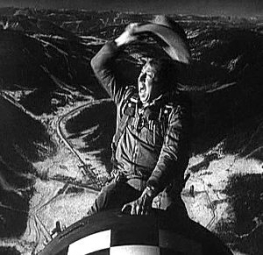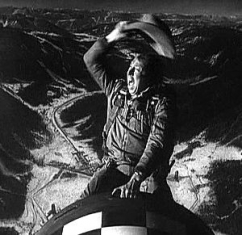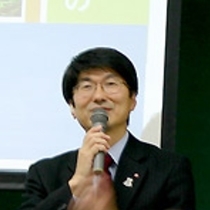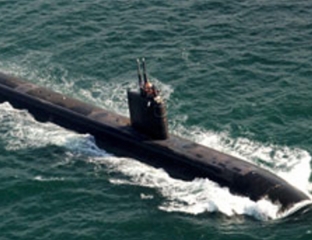Hollywood And The Bomb – or Trivialising a Nuclear Holocaust 1945-1990 – Part 2.
Voice’s Dave Watt lifts the lid on the somewhat shady influences at work at the highest levels of post-war US government when McCarthyism and ‘Commie plot’ paranoia was rife. Not even Hollywood’s cinematic art was safe, it seems.
This section concentrates mainly on Hollywood and the Bomb in the 1950s and 60s with occasional trips across the Atlantic to compare their treatment of the subject with British filmmakers.
Equally upbeat as per the Cheerful Charlie Reader’s Digest was the film Duck and Cover – a civil defence film/public guidance film which first shown publicly in January 1952.
Made with the help of schoolchildren from New York City who were, needless to say, shown ducking under desks and covering their eyes, it was shown in schools as the cornerstone of the government’s “duck and cover” public awareness campaign.
The movie stated that nuclear war could happen at any time without warning and U.S. citizens should keep this constantly in mind and be ever ready (presumably by carrying a school desk around with them).
This was followed up by another public guidance film called The House in the Middle [1954] which was a short documentary film produced by the Federal Civil Defence Administration, which attempted to show that a clean, freshly painted house is more likely to survive a nuclear attack than its poorly maintained counterpart. As it turned out, however, this film was actually sponsored by the US National Paint, Varnish and Lacquer Association so I’d take its nuclear protection advice with a large pinch of salt.
Meanwhile, across the Atlantic in 1950, the first British Nuclear protestor appeared in the film Seven Days to Noon (beating the first Aldermaston March by a clear eight years). Starring Barry Jones and Andrew Morell it showed a British scientist, John Willingdon, running away from a research centre with an atomic bomb which he has in a suitcase. He threatens to blow up the centre of London if the Government don’t agree to stop any further nuclear testing. Special agents from Scotland Yard try to stop him with help from his assistant and her fiancé. In a dramatic finish the scientist is accidentally shot a few minutes before the bomb goes off, the hero marries the heroine and everyone lives happily ever after. Nowadays it seems quite a thought provoking item for the time although in the original film blurb Willingdon the scientist was obligingly referred to as a madman.
Back to the US in 1951 there was a sci- fi film called Five which was a post-apocalyptic US film. The title refers to the number of survivors of an atomic war that wiped out the rest of the human race. Fortunately for the survivors they all lived in the US, spoke English and were within walking distance of each other – just how lucky is that? This was, however, something of a benchmark as it was the first ever film to depict the aftermath of such a catastrophe.
Next film produced by Hollywood with a nuclear war theme was Invasion USA (1952) – basically a pro-military pro-government propaganda film which starts off with a group of anti-government, anti-war people in a bar in Washington decrying the early military-industrial complex of those days.
However, the film goes on to show that while these misguided peaceniks are chewing the fat the evil robotic Soviets are plotting to attack the US with A-Bombs. The A-bombs duly arrive on American air force bases causing mayhem and after a series of horrifying disasters and the usual heroic resistance the few surviving peaceniks are predictably shown to conclude that their government and military were right after all.
their response to any military face confrontation with the Soviets would be a first strike nuclear attack
And I hope they were all thoroughly ashamed of themselves, too. The Soviets in this film were rather confusingly dressed similarly to Nazi SS men – Mind you it probably wouldn’t be too confusing to modern American audiences over 30% of who think the Soviet Union & Germany were on the same side in World War Two anyway.
There was a gap in Hollywood films involving actual nuclear war over the next few years but quite a few pro-military but specifically pro USAAF films. (Just keep remembering here those horrible, pro-commie, fellow traveller, pinkos in the US Navy have been defeated and the United States Army Air Force is the way to go.)
First of these was: James Stewart in Strategic Air Command [1955] , Stewart plays a USAAF Reserve officer recalled reluctantly to active duty to fly bombers for the Strategic Air Command. The film details the duties and responsibilities of being an Air Force strategic bomber pilot, and the strains such service places on family life. Happily, Stewart overcomes all these and goes on to enjoy his new military career defending the USA from the godless Commie threat.
Similarly in Bombers B52 [1957] Karl Malden plays a US air force sergeant who is tempted by a better-paying civilian job. After much moral deliberation Malden decides that he’s of more value in the service and goes on to enjoy his continuing military career defending the USA from the godless Commie threat.
The lack of films depicting a nuclear exchange is particularly significant during this time as the US military was irrevocably committed to the first use of nuclear weapons under the 1951 New Look Strategy -the concept being that the considerably more powerful Soviet forces represented such a world wide threat to US hegemony that their response to any military face confrontation with the Soviets would be a first strike nuclear attack.
In fact, the next film on the subject was produced well after McCarthy’s decline and is the bleakly realistic 1959 film On The Beach which is set in 1964 in the months following World War III. The conflict has devastated the northern hemisphere, polluting the atmosphere with nuclear fallout and killing all human life there while global air currents are slowly carrying the fallout to the southern hemisphere. The only part of the planet still habitable is the far south of the globe, specifically Australia but as the film ends it becomes apparent than everyone is either dying about to die.
Predictably the U.S. Department of Defence refused to cooperate in the production of this little item, refusing access to their nuclear-powered submarines and the film production crew was forced to use a non-nuclear Royal Navy submarine, the HMS Andrew.
The US contrived to lose seven nukes in the years after the WW2 which means that they’re lying around somewhere rusting quietly away.
Despite the loan of the HMS Andrew this did not indicate an anti nuclear stance by the British Government and, in fact, the then Foreign Secretary and future Tory Prime Minister Sir Alec Douglas Hume stated in June 1961 that in their commitment to NATO and the US that “The British people are prepared to be blown to atomic dust if necessary” which must have been news to most of the population.
Following the the international concern over the Cuban Missile Crisis in 1962 and the groundbreaking film of’ On The Beach’ and there appeared a reaction to this within the US establishment which contradicted the previously held view characterised by the Rand Corporation’s Herman Kahn ‘On Thermonuclear War’ (1960) which postulated the idea yet again of a ‘winnable nuclear war’.
This public outcry engendered by the Cuban Missile Crisis caused Kahn’s to amend his following books ‘Thinking About The Unthinkable (1962) and On Escalation (1965) backpedalled a bit and produced such delights as his Escalation Ladder (seehttp://www.texaschapbookpress.com/magellanslog41/escalation.htm) which ranges from Ostensible Crisis and Political, Economic & Diplomatic Gestures for 44 stages up to Unmodified Counterforce Attack or Spasm and Insensate War – which apparently means firing off everything nuclear you’ve got in the general direction of the enemy. According to Mr Kahn, 24 of these 44 stages involve a ‘nuclear exchange’.
Next film up was A Gathering of Eagles [1963] a movie about the Cold War and the pressures of Air Force command. Rock Hudson plays a USAAF Colonel, Jim Caldwell, who despite his misgivings is promoted to be a Strategic Air Command B-52 wing commander –. Needless to say Hudson predictably overcomes all the tribulations and pressures of command and like Karl Malden and Jimmy Stewart goes on to enjoy his new military career defending the USA from the godless Commie threat.
This film was heavily supported by the USAAF and SAC commander Curtis Lemay in particular as it showed SAC in the most promising light imaginable as intelligently led, competent and relentlessly efficient whereas they had been receiving a fair bit of flak for several major nuclear accidents. The US contrived to lose seven nukes in the years after the WW2 which means that they’re lying around somewhere rusting quietly away.
the last poignant scene is of nuclear blasts all over the globe as Vera Lynn sings ‘We’ll Meet Again’.
Curtis LeMay may be a name familiar to some of you as a rather deranged US superhawk very keen on using B52s in Vietnam and was extremely miffed when LBJ stopped him dropping a nuke in front of the threatened US marine base at Khe Sanh in 1967. His alter ego, General Turgidson, was played by George C Scott in the next film which is:
Dr. Strangelove or: How I Learned to Stop Worrying and Love the Bomb which is a 1964 American/British black comedy film directed by Stanley Kubrick, starring Peter Sellers and George C. Scott, and featuring Sterling Hayden, Keenan Wynn and Slim Pickens..
The story concerns an unhinged US Air Force general Jack D Ripper who orders a first strike nuclear attack on the Soviet Union, and follows the President of the United States, his advisors, the Joint Chiefs of Staff and an RAF officer as they try to recall the bombers to prevent a nuclear apocalypse, as well as the crew of one B-52 as they attempt to deliver their payload. The situation is made more critical by the Soviet Union having created a Doomsday Machine which will fire off a huge cloud of radioactive dust which will envelop the earth if a nuke hits the Soviet Union. The bomber eventually hits a tertiary target within the Soviet Union and the last poignant scene is of nuclear blasts all over the globe as Vera Lynn sings ‘We’ll Meet Again’.
A similar theme appears in Fail-Safe (1964) Sidney Lumet’s original 1964 film employs a stylized and heightened dramatic structure in its nerve-crushing moral tale. When an off-course commercial airplane triggers the Pentagon’s complex “fail-safe” maneuver, leaving an arsenal of nuclear-bomb-carrying jet fighters at the ready, a mechanical error puts the entire world in danger of destruction.
Walter Matthau gives an uncharacteristic turn as an unpleasantly cold and contemptuous political scientist Prof. Groteschele, apparently based on Herman Kahn. Henry Fonda plays the American president who manages with the Soviet Premiere to navigate the complex and urgent political trauma and prevent total destruction. As one of the American bombers makes it through to drop an A-bomb on Moscow the only concession the US President can offer to prevent all out war is to drop a similar bomb on New York.
This duly happens (thus incidentally invoking Mr Kahn’s Stage 29 of his Escalation Ladder ‘Exemplary Attack on Population’) and the countdown to the bomb hitting New York involves a series of movie stills taken in the streets of the city.
Back across the Atlantic, The War Game was a 1965 television film on nuclear war. Written, directed, and produced by Peter Watkins for the BBC’s The Wednesday Play strand, its graphic depiction of the impact of a Soviet nuclear attack on Britain caused dismay within the BBC and in government.
It was scheduled for transmission on 6th of August 1966 but the effect of the film was judged by the BBC to be “too horrifying for the medium of broadcasting” and it was not actually transmitted for 19 years and eventually appeared on the BBC in 1985, Presumably, following this timescale they’ll get around to broadcasting the appeal for Gaza in 2038.
Back in Hollywood the forces of good were still battling for God & Profit but a lot of public questioning was going on about US involvement in Laos and Vietnam and the next film revealed a certain ambivalence in US society.
In The Bedford Incident (1965) Richard Widmark plays the stern and unforgiving skipper of an American destroyer on peacetime patrol in North Atlantic waters as an element of the NATO fleet. He develops an obsessive determination to hunt down a Soviet submarine and as the danger in his compulsive chase develops a fatal incident occurs with the US destroyer firing off its missile and the Soviet submarine retaliating with its nuclear weaponry and both are utterly destroyed.
Part 3 (The 1970s onwards) -next week.







